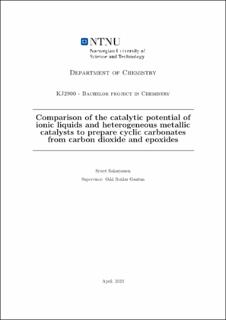Comparison of the catalytic potential of ionic liquids and heterogeneous metallic catalysts to prepare cyclic carbonates from carbon dioxide and epoxides
Bachelor thesis
Permanent lenke
https://hdl.handle.net/11250/3071416Utgivelsesdato
2023Metadata
Vis full innførselSamlinger
- Institutt for kjemi [1390]
Sammendrag
Fiksering av CO2 for å produsere nyttige kjemikalier har blitt studert lenge. Spesielt syntesen avsykliske karbonater fra CO2 og epoksider har blitt utforsket. Denne raporten har foksuert på toforskjellige katalysatorer og deres potensial for å katalysere sykliske karbonat synteser. En av disseer ionsik væske (IL) katalysatorer og den andre er metal holdige hetrogene katalysatorer. For godselektivitet og utbytte må reaksjonen gjennomføres ved 3 Mpa CO2 og 140 °C. IL katalysatorenehar et anion som promoterer reaksjonen og reaksjonsraten øker med anionets nukleofilisitet. Reak-sjonshastigheten er høyere med IL katalyster enn metalliske. IL katalysetorer taper mer katalystnår de regenereres og krever mer energi for hver syklus. Det finnes måter å redusere tap av katalystog energi for å gjøre de mer like. Totalt sett er IL katalysatorer mer lovende siden de har høyerereaktivitet enn metalliske. The fixation of CO2 to produce useful chemicals has been studied for a long time. Particularly thesynthesis of cyclic carbonates from CO2 and epoxides has been studied extensively. This report haslooked at two different types of catalysts and their potential for catalysing the synthesis of cycliccarbonbates. One is ionic liquids (IL) and the other is metal containing heterogeneous catalysts.For good selectivity and yield, the reaction should proceed at a pressure of 3 Mpa of CO2 at140 °C. The IL catalysts have an anion to promote the reaction and the rate of the reactionincreases with nucleophilicity. The reaction speed is higher with IL catalysts than the metallicones. IL catalysts lose more catalyst when it is regenerated and requires more energy per cycle toseparate the product and regenerate the catalyst than metal heterogeneous catalysts. There areways to mitigate loss and energy consumption to make them more similar. In total IL catalystsdue to their higher reactivity seem more promising than metallic catalysts.
